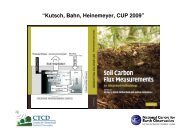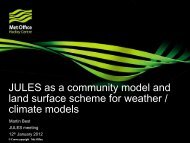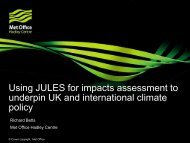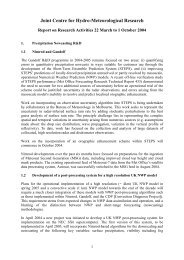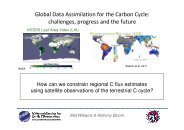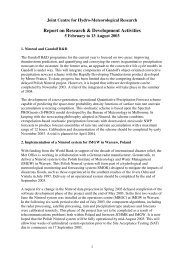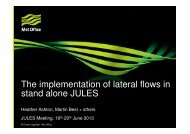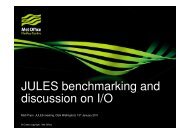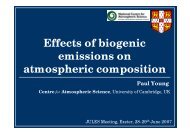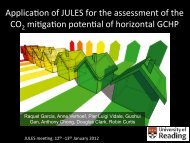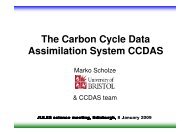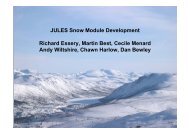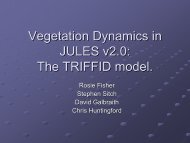Report - Joint Centre for Hydro-Meteorological Research
Report - Joint Centre for Hydro-Meteorological Research
Report - Joint Centre for Hydro-Meteorological Research
You also want an ePaper? Increase the reach of your titles
YUMPU automatically turns print PDFs into web optimized ePapers that Google loves.
As part of this new initiative members of staff within the climate area of JCHMR (both MetOffice and CEH) are involved. IMOGEN has been rewritten to enable easy exchange of landcarbon cycle model, i.e. it can be coupled to other DGVMs. A standard simulation protocol hasbeen written and adopted by each DGVM group. Each group have coupled their DGVM intoIMOGEN and are currently running coupled climate-carbon cycle simulations with theirDGVM <strong>for</strong> 4 future CO 2 emission scenarios and the analogue climate pattern of HadCM3.9.4 Wetland methane emission feedback on climate changeAtmospheric methane concentrations and temperature trends have been highly correlated in thelong-term historical records, implying that changes in climate modify the wetlands sourceand/or the atmospheric sink terms occurred. In order to reduce uncertainty in our assessment ofthe impact of future wetlands methane emissions on climate change (Gedney et al., 2004), anoff-line simulation of the Last Glacial Maximum (LGM) is being conducted. This simulates asignificant increase in potential wetland extent and methane flux in the present day relative tothe LGM, which is in general agreement with observationally based data. The results alsosuggest that recent draining of land <strong>for</strong> agricultural purposes appears to be a significant factorin determining the net global methane flux <strong>for</strong> present day.9.5 Climate change: Detection and AttributionWork is underway to analyse the runoff time series over the 20th Century at the regional scale.The Met Office Surface Exchanges Scheme (MOSES) is <strong>for</strong>ced off-line with observed data(e.g. precipitation and temperature) and the resulting modelled runoff patterns are comparedwith those observed. Using this methodology we are aiming to "attribute" runoff changes dueto various factors .e.g. land use.10. JCHMR FellowshipWork continues on how best to exploit satellite data to initialize soil moisture <strong>for</strong> short term<strong>for</strong>ecasts. The study area is West Africa, where strong surface soil moisture gradients candevelop due to the passage of mesoscale convective storm systems. The case of interestoccurred during August 2004 and is associated with the rapid intensification of a weathersystem which trans<strong>for</strong>med into a tropical cyclone downstream of the continent. A pattern ofwet and dry patches on spatial scales of the order of hundreds of kilometres are readilyapparent from infra-red and microwave satellite imagery. We have been investigating how tobest utilize the near-surface soil moisture product from the AMSR-E microwave sensor onboard the AQUA satellite. Inspection of time series of soil moisture suggest that the estimatessuffer from low frequency biases, possibly due to the slowly evolving vegetation canopy. Thismakes the direct use of the data problematic. An alternative qualitative method to initialize soilmoisture has been explored based solely on the higher frequency data (daily anomalies from alonger term mean). When introduced into the atmospheric model, this method significantlyreduces boundary layer temperature biases. Under the <strong>for</strong>thcoming African MonsoonMultidisciplinary Analyses (AMMA) project, a range of methods <strong>for</strong> generating soil moistureanalyses will be explored.7



